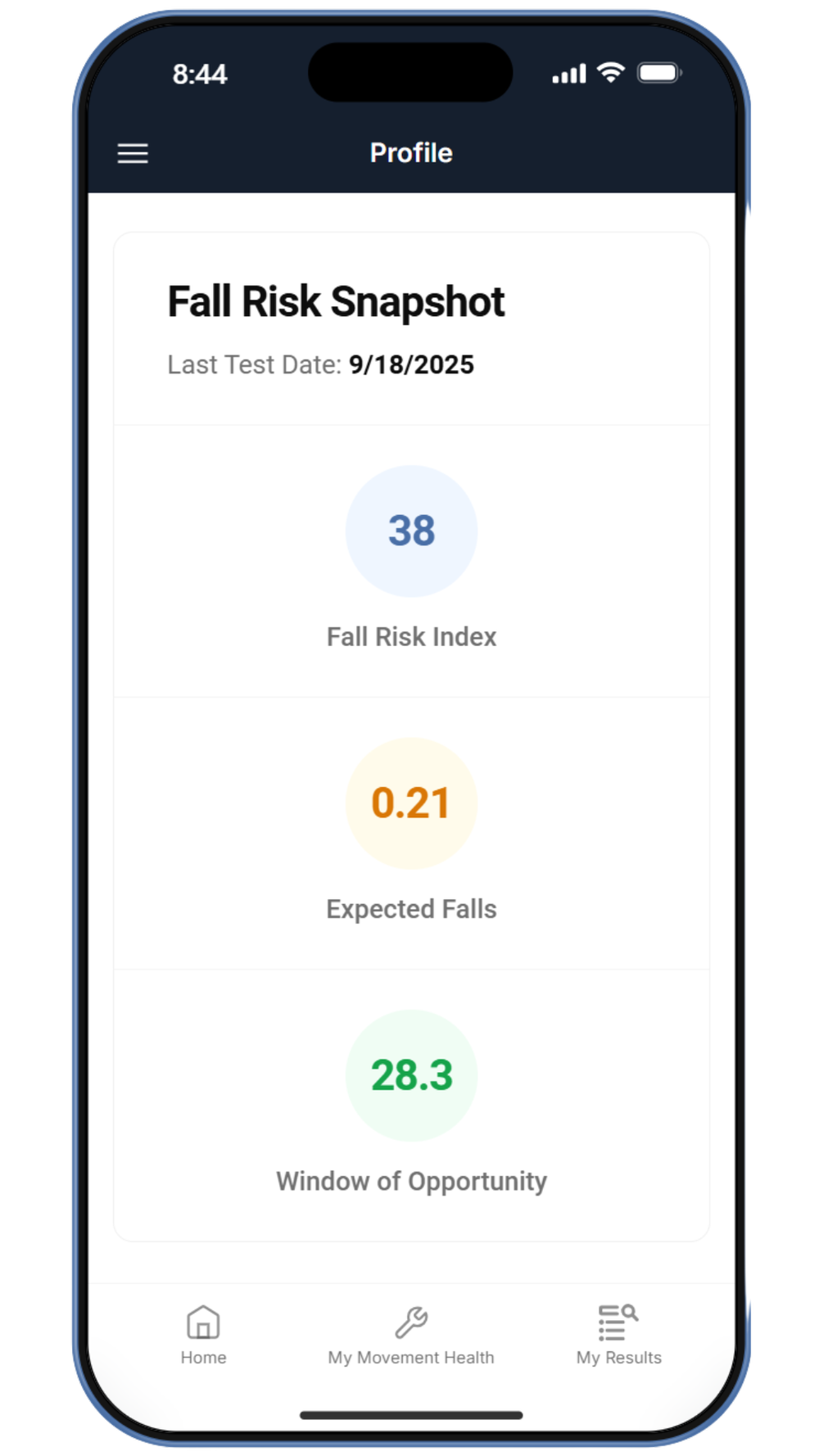
Movement is Your Data.
Prevention is Your Power.
Your Independence is Written in Your Movement.
One fall can take away your independence.
Preventing one fall can mean
With Moviq Health, preventing one fall is not luck; it is science applied with care, and it means more years of strength, freedom, and connection.
How Moviq Health Works
By converting movement into data, we deliver truly personalized fall prevention to help you stay strong, confident, and independent.

Each session measures biomechanical metrics using 3D gait capture, force plate, and balance plate.
Your results are compared to healthy reference to identify elevated risk patterns.
We apply predictive modeling to estimate a 12-month fall projection from your biomechanical data, enabling true prevention.
You’ll receive an interactive dashboard and meet with a licensed Physical Therapist to create a personalized prevention plan.
What We Measure
3D gait analysis
Gait Speed (m/s)
Cadence (steps/min)
Double Stance Support (%)
Step Width (cm)
Stride Length (cm)
Ground Contact Time (ms)
Duty Factor (%)
Trunk Rotation (°)
Pelvic Rotation (°)
Hip Flexion (°)
Knee Flexion (°)
Ankle Dorsiflexion (°)
Pelvic Drop (°)
Hip Adduction (°)
Hip Internal Rotation (°)
Knee Flexion (°)
Ankle Pronation (°)
Foot Rotation (°)
Pelvic Tilt (°)
Hip Extension (°)
Ankle Dorsiflexion (°)
Ankle Pronation (°)
Foot Clearance (cm)
force plate analysis
Relative Net Force (N/kg)
Relative Rate of Force Development (N/s/kg)
Relative Net Impulse (N·s/kg)
Force Symmetry Index (%)
Relative Net Force (N/kg)
Relative Rate of Force Development (N/s/kg)
Relative Net Impulse (N·s/kg)
Force Symmetry Index (%)
Force Steadiness (%)
balance plate analysis
Postural Sway (cm)
Eyes Open & Firm (cm)
Eyes Closed & Firm (cm)
Eyes Open & Foam (cm)
Eyes Closed & Foam (cm)
Total Area (cm²)
Front-Left Quadrant (cm²)
Front-Right Quadrant (cm²)
Back-Left Quadrant (cm²)
Back-Right Quadrant (cm²)
Predictive Analytics
Moviq Health analyzes 60+ biomechanical markers to generate your personalized fall risk profile, revealing where you stand today and where you will be tomorrow.
Fall Risk Index
Your current fall risk based on your biomechanical data. Lower values indicate stronger, more resilient movement.
Expected Falls
Your projected number of falls over the next 12 months, derived from predictive modeling.
Window of Opportunity
Expected duration of risk stability, calculated using Poisson probability modeling based on Expected Falls.
Why Choose Moviq Health?
Data-Driven Assessment
Moviq Health captures biomechanical metrics to measure movement objectively and detect early changes with clinical precision.
Predictive Analytics for Early Action
Algorithms trained using large datasets to forecast future fall risk to truly enable fall prevention.
Biomechanics Expertise, Made Practical
We translate complex movement data into simple, sustainable steps that protect confidence, capability, and independence.



⅓ of Falls Are Preventable
Research shows falls can be prevented when risk factors are measured and managed.
Moviq Health brings your risks into focus through predictive biomechanical analysis, helping you take actions before falls.

Precision = Prevention
- Detects early signs of decline that precede falls
- Provides a personalized fall prevention plan to protect your independence
- Tracks measurable progress from every follow-up test
Moviq Health uses biomechanics and data analytics to identify early signs of decline, project your fall risk, and design personalized fall prevention plans.

Stay Ahead of Decline. Stay in Control.
Muscle loss begins in your 30s and accelerates after 50. Strength, balance, and coordination begin to fade long before the fall. By the time decline is visible, much of your mobility loss have already occurred.
Your body compensates by making microscopic changes to your gait, posture, and muscle recruitment patterns. These adjustments keep you moving but increase joint stress and reduce stability over time.
By detecting these subtle, early changes through biomechanics assessment, we can intervene long before your independence breaks down.
Real stories. Real results.
“I thought I was fine, but Moviq Health showed me I was slowing down. Now I’ve started training and feel steadier already.”
“I used to worry about my dad living alone. Now I’m confident he can and we have a clear plan.”
“The testing gave me concrete numbers to work on. For the first time, I know exactly what I need to improve.”
“I feel more confident walking outside now. It’s reassuring to see my scores improve each visit.”
Everything you need to know
About Moviq Health
Who is the assessment for?
What’s included in the $249 test?
Is it safe?
Logistics
How long does the visit take?
How soon do I get my results?
What should I wear or bring?
Where are you located?
Can I reschedule or cancel?
I use an assistive device to walk. Can I still get the test?
Medical & payment
Do you take insurance?
Do I need a referral from my doctor?
What happens after the test?

Locations We Serve
Now Serving Nevada
We currently operate in Las Vegas, Nevada, providing in-person biomechanical testing and fall risk analysis. New testing locations are coming soon.
